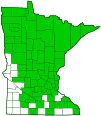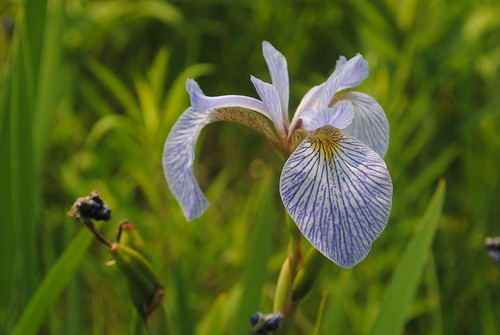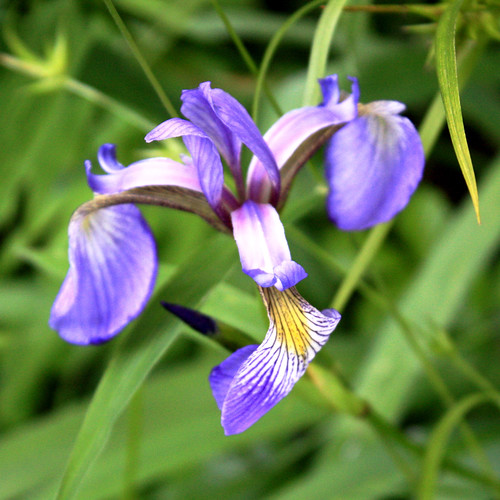northern blue flag
(Iris versicolor)
Conservation • Wetland • Description • Habitat • Ecology • Use • Distribution • Taxonomy
Description |
||
Northern blue flag is a 24″ to 36″ tall, erect, perennial forb that rises on a single stem from a thick, creeping, freely-branching rhizome and fleshy roots. It often forms large clumps. The stems are erect, stout, nearly straight, and usually have 1 or 2 branches. The top of the stem is equal to or higher than the leaves. Basal leaves are narrowly sword-shaped, green to grayish-green, 4″ to 32″ long, and ⅜″ to 1 3 ⁄16″ wide. They are erect and commonly arching near the top. There are 1 or 2 leaves on the stem subtending each branch. Stem leaves are similar to the basal leaves but shorter. The inflorescence is a cluster of 2 to 4 flowers at the end of each stem and branch. The cluster emerges from an enveloping pair of large bracts (spathes). The flowers are 2½″ to 3½″ wide. There are 3 petals and 3 petal-like sepals, all of which are fused at the base into a ⅜″ to ½″ long tube. Each sepal is egg-shaped to kidney-shaped, widely spreading, 1½″ to 2¾″ long, and ¾″ to 1½″ wide. It is abruptly or gradually narrowed toward the base (clawed) and broadly expanded toward the tip. It is violet blue near the tip and white with heavy purple veins from the middle to the base. There is a greenish-yellow patch near the throat. What appears to be an upper lip is actually a branch of the style. The highly modified style is enlarged and divided into 3 branches. Each petal-like style branch covers the lower portion of a one sepal, extending just beyond the narrowed claw and concealing the stamens. The style branch is 1 3 ⁄16″ to 1⅜″ long, distinctly ridged, and flared at the tip. It does not have ear-like lobes at the base. The 3 petals are much smaller than the sepals. They are lance-shaped, erect, ¾″ to 2″ long, and 3 ⁄16″ to ¾″ wide. They are rarely notched at the tip. The flowers last 1 to 4 days and are somewhat fragrant. All white flowers are found, though rarely. The fruit is a green, oblong, three-sided, 1½″ to 2⅜″ long, ½″ to ¾″ in diameter capsule. It is rounded-triangular in cross section. |
||
Height |
||
24″ to 36″ |
||
Flower Color |
||
Violet blue |
||
Similar Species |
||
Southern blue flag (Iris virginica var. shrevei) stem leaves often exceed the inflorescence. The sepals and petals are lighter in color, lavender to violet. The patch at the base of the sepals is bright yellow, not yellowish-green. The 3 petals are often notched at the tip. |
||
Habitat |
||
Wet. Meadows, swamps, marshes, streambanks. In water less than 40″ deep. Full to partial sun. |
||
Ecology |
||
Flowering |
||
June to July |
||
Pests and Diseases |
||
|
||
Use |
||
|
||
Distribution |
||||
|
Sources |
|||
| 5/20/2023 | ||||
Nativity |
||||
Native |
||||
Occurrence |
||||
Common |
||||
Taxonomy |
|||
| Kingdom | Plantae (Plants) | ||
| Division | Tracheophyta (Vascular Plants) | ||
| Subdivision | Spermatophytina (Seed Plants) | ||
| Class | Liliopsida (Monocots) | ||
Order |
Asparagales (Agaves, Orchids, Irises, and Allies) | ||
Family |
Iridaceae (irises and allies) | ||
| Subfamily | Iridoideae | ||
| Tribe | Irideae | ||
Genus |
Iris (irises) | ||
| Subgenus | Limniris | ||
| Section | Limniris | ||
| Series | Laevigatae | ||
Synonyms |
|||
Iris versicolor var. versicolor |
|||
Common Names |
|||
blue flag iris harlequin blueflag northern blue flag northern iris |
|||
Glossary
Bract
Modified leaf at the base of a flower stalk, flower cluster, or inflorescence.
Claw
A stalk-like narrowed base of some petals and sepals.
Linear
Long, straight, and narrow, with more or less parallel sides, like a blade of grass.
Rhizome
A horizontal, usually underground stem. It serves as a reproductive structure, producing roots below and shoots above at the nodes.
Sepal
An outer floral leaf, usually green but sometimes colored, at the base of a flower.
Spathe
One or two large bracts that subtend, hood, or sometimes envelope a flower or flower cluster, as with a Jack-in-the-Pulpit.
Visitor Photos |
|||||
Share your photo of this plant. |
|||||
| This button not working for you? Simply email us at info@MinnesotaSeasons.com. Attach one or more photos and, if you like, a caption. |
|||||
|
|||||
MinnesotaSeasons.com Photos |
|||||
Habitat |
|||||
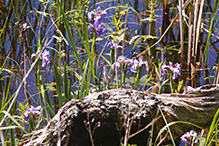 |
|||||
Plant |
|||||
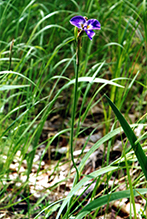 |
|||||
Inflorescence |
|||||
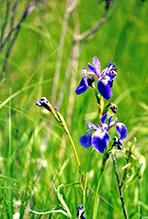 |
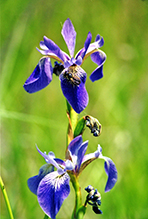 |
||||
Flower |
|||||
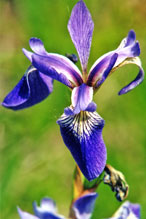 |
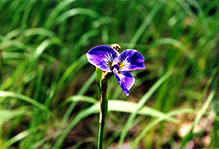 |
||||
Infructescence |
|||||
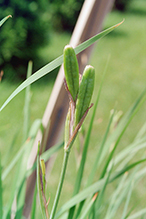 |
|||||

Visitor Videos |
|||
Share your video of this plant. |
|||
| This button not working for you? Simply email us at info@MinnesotaSeasons.com. Attach a video, a YouTube link, or a cloud storage link. |
|||
Other Videos |
|||
| Blue Flags in the Bluebelt rjproducer37 |
|||
About
Uploaded on Jun 4, 2008 Iris, the Latin for Iris versicolor, from the Latin, "with various colors". Blue Flag, from its flower color and the old word for Iris. Other common names include: The bluebelt is man-made and abounds with local native plantings and each rock is laid in by hand. |
|||
| Minnesota Native Plant - Northern Blue Flag (Iris Versicolor) MNNativePlants |
|||
About
Published on Jun 13, 2014 Rich shows off the Northern Blue Flag (Iris Versicolor) around the pond. A great plant for a Minnesota native wetland or water garden! |
|||

Visitor Sightings |
|||||
Report a sighting of this plant. |
|||||
| This button not working for you? Simply email us at info@MinnesotaSeasons.com. Be sure to include a location. |
|||||
| Kathy and Douglas Wood 1994 to present |
Location: Stearns County, Brockway township along the Mississippi. we have a clump of these growing in our 100+ year old woods. Beautiful color! |
||||
MinnesotaSeasons.com Sightings |
|||||

|
Created: Last Updated: © MinnesotaSeasons.com. All rights reserved. |
